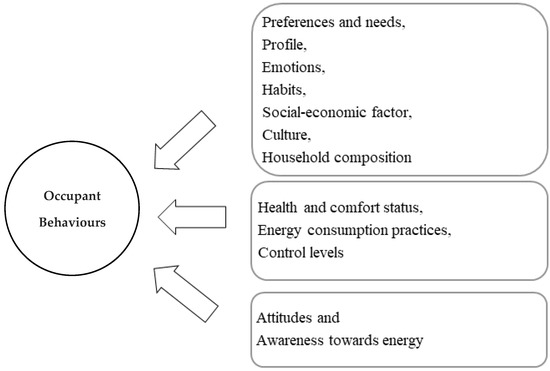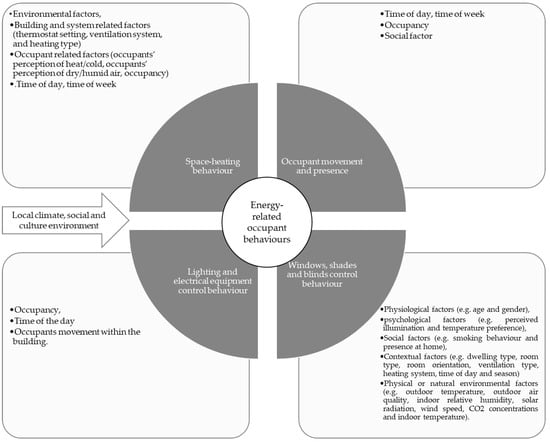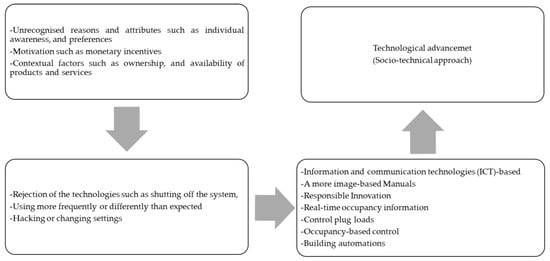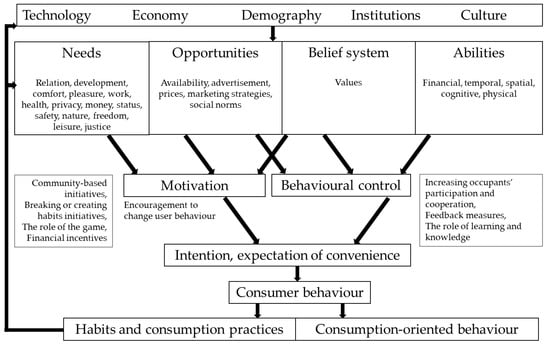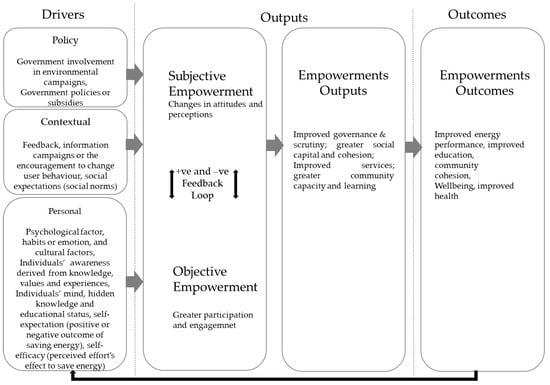1. Types of the EER and the Systems
‘Low-energy houses’ (LEHs), ‘passive houses’ (PHs), or ‘zero-energy houses’ (ZEHs) are general terms for different types of EER. ‘Low energy’ refers to buildings with the aim of less energy usage without any special requirements. While, ‘passive’ houses, have to fulfill specific requirements, including a maximum end-energy use for space heating and limited primary energy demand for all end-users. ‘Zero energy’ generally refers to net zero energy, which means a building where the net energy consumed over one year is equal to the amount of energy produced on-site
[1][10]. However, both passive houses and NZEBs mainly have to meet their energy demands by building-integrated renewable energy sources
[2][11]. The different types of EER buildings
[1][3][10,12] and their components in both passive houses and NZEBs
[3][4][5][6][12,13,14,15], the factors that have to be considered during retrofitting
[4][7][8][9][10][11][13,16,17,18,19,20], and the energy-saving measures (ESMs)
[9][11][18,20] are studied by many scholars.
Energy-efficient or high-efficiency buildings are not included only in new construction, and existing buildings can also be renovated as per the high-energy efficiency standard
[12][13][21,22]. Energy efficiency renovations can contribute significantly to reducing energy consumption and achieving the EU and national energy efficiency targets
[14][23]. EER of residential buildings is a key measure in the contribution of energy conservation and improves the life quality level of people as well
[15][24]. Retrofitting approaches have to emphasize technical-material changes in order to focus equally on researching and potentially changing the energy-related purposes and actual activities of the occupants of ERBs. The concept of energy culture is a useful investigation to analyze the household energy demand and the indoor environment. Three key elements of energy culture have been described in the study by Rau, Moran
[16][25] and the results show that in order to achieve actual and long-term energy consumption reductions, it is crucial to consider an integrated approach that combines technology-aided changes and reforming of occupants’ attitudes and practices, simultaneously
[16][25].
Since the interactions have two players including the human and the building (systems); hence, the occupants have to be considered in the design process of control systems and building infrastructure. In terms of occupants, it is suggested to understand their comfort perceptions, emotions, behaviours and awareness qualitatively and quantitatively, as well as control levels, and attitudes towards energy, needs, and habits. Whereas, on the building and systems side, elements such as usability, quality, affordances and layout have to be considered
[17][18][26,27]. As the building systems, environment and occupant are interrelated, particularly in the indoor environment, every action, behaviour or habit exercised by the individual can affect the environment, and subsequently, the environment influences the action and the behaviour of the person. Consequently, it is essential to understand the components better through an integrated analysis of occupant behaviours and the indoor environment. In terms of occupants’ behaviours, their preferences and needs, profiles, intentions (locus of control, emotions, attitudes, social factors); habits; and health and comfort status have to be considered. On the indoor environment side, occupants are exposed to the positive and negative stressors that influence their behaviours
[19][20][28,29]. Therefore, interdisciplinary studies are required to study the interactions between occupants’ behaviours, preferences and needs towards energy, comfort, health, energy-efficient systems, and the indoor environment. Moreover, it is required to integrate knowledge from the indoor environment, energy, behaviour, and design sciences. Learning from real case studies, from the design step to early occupation leads to understanding the drivers of energy efficiency, IEQ, and health in residential buildings
[21][22][30,31]. The energy performance gap generated by the buildings’ characteristics, technologies, and occupants’ behaviours is shown in
Table 12.
Table 12.
The effective factors on energy performance gap related to the buildings’ characteristics and occupants’ behaviours.
2. Energy Consumption Patterns of Occupants
The energy consumption of buildings shows a strong relationship with the occupants’ activities. A key factor in controlling building energy usage is a lack of understanding of occupant behaviours. The critical review paper of Harputlugil and de Wilde
[29][38] has identified the existing gaps in the previous research on energy-related occupant behaviours. They stated that the majority of the research focuses on technical aspects rather than socio-economic issues
[29][38]. Moreover, “comfort” and “health” are ignored in the previous studies, and both are rarely measured. Consequently, occupant behaviours, preferences and needs are understudied and required to be integrated into the research and development of retrofitting measures
[21][30]. Reducing energy consumption, despite the installation of energy retrofitting technologies, is partially related to the occupants (behaviours, preferences, needs, awareness) and to some extent is also due to technical issues. The factors identified in prior studies
[17][18][21][30][26,27,30,39] which are effective on behaviours of the occupants in energy consumption are shown in
Figure 1.
Figure 1. Effective factors on occupant behaviours energy use [17][18][21][30]. Effective factors on occupant behaviours energy use [26,27,30,39].
The study of Santin, Itard
[31][40] showed that some occupant behaviours is defined by the type of house or HVAC systems, and consequently, the effect of occupant characteristics might be larger than expected, since these specify the type of residence
[31][40]. Gardner and Stern
[32][41] have defined two types of behaviours (efficiency and curtailment behaviours) related to energy conservation in their studies. Window-opening behaviour is one sort of energy-related behaviours that has been discussed in prior studies, extensively. According to the literature findings, five categories of significant variables influencing window opening behaviour for residential buildings include physiological factors (e.g., age and gender), psychological factors (e.g., perceived illumination and temperature preference), social factors (e.g., smoking behaviour and presence at home), contextual factors (e.g., dwelling type, room type, room orientation, ventilation type, heating system, time of day and season) and natural environmental factors (e.g., outdoor temperature, outdoor air quality, indoor relative humidity, solar radiation, wind speed, CO
2 concentrations and indoor temperature)
[33][42]. Lighting control behaviour is an attractive topic for some researchers as well
[34][35][43,44]. Occupancy, time of the day, and occupants’ movement within the building are effective in the lighting behaviour of occupants
[36][45]. Space heating/cooling behaviour is another type of behaviour that has been mainly discussed
[33][42]. The case study of houses in the Netherlands has highlighted the main factors that are effective on heating behaviour and energy consumption, such as occupants’ thermal comfort perception, occupancy, time of the day, thermostat setting, ventilation system, and heating type
[37][46].
Consequently, the variedenergy consumption of occupants is based on their lifestyles (different attitudes, habits, clothes, beliefs, and culture), limitations (age, gender, vulnerability, metabolic heat, thermal sensitivity, and safety), and indoor environment quality (different aspects of comfort levels for thermal, acoustic, indoor air quality, and visual)
[29][38]. The research team van den Brom, Hansen
[38][47] have studied the impacts of the house type and the building characteristics on the energy consumption of occupants. For example, the occupants’ impact is greater for energy-efficient houses than for energy-inefficient dwellings
[38][47]. Furthermore, occupants with a high income can save more energy than occupants with a low income. Moreover, residential buildings with employed occupants make more use of improved building installations than those occupied by unemployed occupants. However, it is not found that the number of occupants per house has a significant effect
[11][20].
Pothitou, Kolios
[39][48] concluded that surveys that were conducted based on qualitative research;
[40][41][42][43][44][45][46][49,50,51,52,53,54,55] revealed consumption patterns and routines in daily occupants’ life. It can be summarized as: occupants’ unawareness of annual energy and water consumption; a gap in the public’s awareness of global warming and the effect of heating and cooling homes on climate change
[47][56]; no consumers’ environmental behavioural change despite environmental issues concerns
[48][57] due to the initial cost of energy-efficient products and the lack of public funds as the main barriers
[49][58]; and no new behaviour adoption despite awareness of household or practices to reduce energy consumption due to the occupants’ habits. Therefore, the lack of occupants’ awareness of energy-saving behaviours and their daily practices causes an energy performance gap, which is described in the following section.
Research on occupant behaviours has been concentrated on various specific behaviours, such as window opening behaviour, lighting control behaviour and space heating/cooling. This indicates that there is a need to further understand occupants’ behaviours regarding energy use in buildings.
Furthermore, a systematic framework will lead to model and capturing the interaction between occupants and building energy systems from different perspectives through an integrated evaluation system. Additionally, there are insufficient data on behaviour profiles and energy use in actual buildings. The socio-economic context can contribute to the understanding of occupant behaviours and enlighten approaches to encourage more energy-efficient behaviours.
Likewise, more research is required to integrate behavioural factors with energy policy making. The role of occupant behaviours in the energy efficiency policy of buildings is a large research gap. Policymakers would improve building energy efficiency policy by recognizing occupant behaviour’s impact on the effectiveness of relevant policies
[33][42].
As a consequence, the effective factors influencing the energy efficiency of the buildings that need occupants’ participation, as well, are shown in Table 23.
Table 23.
Effective factors on energy efficiency renovation with respect to the occupants’ participation.
3. People’s Behavioural Factors in EER
As aforementioned, energy-related occupants’ behaviours depend on their comfort, and mainly, on their thermal comfort
[52][61]. People’s behaviours can be categorized into three types: (1) physiological adaptation; (2) psychological adaptation; and (3) behavioural adaptation
[53][62]. These three adaptations are related to the local weather climate and the social and cultural environment. Behavioural adaptation is the main factor in which individuals adjust their body heat balance by changing themselves or the environment to keep thermal comfort. In order to avoid discomfort, people change themselves through clothing adjustments, or in other ways, such as posture
[54][63] or activity changes. People change the environment to maintain thermal comfort by opening windows, drawing blinds, or changing their location to a more comfortable space. Mechanical systems usage such as heating, cooling, or fans are examples of adaptive behaviours
[55][64]. As an example, the findings of the case study of Bonte, Thellier
[52][61] on an office show that the major behaviour on total energy demand is the actions on set-point temperature, blinds, and lights. Moreover, the main behaviour on thermal comfort is changing the set-point temperature, clothing insulation, and blinds. Particularly, the occupants’ habit cause (mis)use of the control systems of the comfort providing appliances, by some activities including radiator control (adjusting thermostat settings), opening/closing windows, dimming/switching lights, shade control (pulling up/down blinds), turning on/off HVAC systems and movement between spaces
[21][33][56][30,42,65]. Furthermore, behavioural adaptations, for instance, clothing adjustments, drinks consumption and human metabolic rate changes, directly affect an individual’s comfort and building energy consumption, subsequently. Therefore, both direct and indirect drivers, at the individual, local, whole-space or zonal levels affect the building energy consumption differently
[56][65].
Many scholars studied window, shades and blinds control behaviour
[57][58][66,67]. The most important issue between perceived IEQ and outdoors is the building envelope
[59][68]. Window operation provides occupants with the desired indoor thermal and air quality conditions through adjustments to air movements throughout the building. Additionally, as the building envelope is being more thermally efficient, ventilation and air infiltrations as a result of window opening are increasing their impacts on energy use, and, accordingly, becoming the main source of thermal loss of the heat balance mechanism. According to Humphrey’s adaptive principle, if a change happens to cause discomfort, people respond in a way that tends to restore their comfort
[60][69]. Windows, shades, and blinds allow occupants to control and adjust thermal and visual comfort levels. Similarly, the position and frequency of interaction with portable shading and blinds affect the building energy consumption, peak loads and visual and thermal comfort. Appropriate windows, shades, and blind interactions provide an energy-efficient strategy. However, the contrary interactions easily lead to energy waste
[61][62][70,71]. Stakeholders have predicted that the residents are key players in the success of the project. For instance, when the heating system is on, the residents need to keep the windows closed. Furthermore, some residents may open windows for ventilation, which results in more energy consumption in winter, while balanced ventilation with heat recovery provides fresh air
[27][36].
Some scholars have studied space heating/cooling behaviour. The interaction of occupants with building systems is effective in the total energy consumption of buildings. Hence, occupant behaviours is the most important cause of uncertainty in energy use prediction
[63][72]. Therefore, to link the gap between actual and expected energy consumption, there is a need to understand occupant-building interactions
[64][73]. Langevin, Wen
[65][74] revealed that individual heating/cooling device usage increases the thermostat set-point enhancing thermal comfort, whereas they reduce the overall energy consumption. Energy consumption can vary according to the HVAC control strategy, with the main physical-behavioural services including ventilation, thermostat set-point, and indoor thermal environment
[66][67][75,76]. Some of the main effective factors on heating loads include occupant mode, thermostat set-point and heated area
[52][68][61,77]. Classifying the occupant as either an active, medium, or passive user, and connecting occupant behavioural characteristics to heating set-point preferences, influences the indoor thermal environment and energy consumption
[69][70][78,79]. Technical solutions that limit the interaction of occupants with technology are a strong solution to reduce wasted energy. Though, it is recommended that the thermal control perception and higher occupant satisfaction, designate a solution that required occupant-building interactions
[71][80]. Regarding the conceptual framework on the habitual behavioural change proposed by Pothitou, Kolios
[39][48], and the prior research
[31][33][36][37][72][40,42,45,46,81], the study has developed the conceptual framework of occupants’ energy-related behaviours (
Figure 2).
Table 34 has listed the effective factors on energy-related behaviours of occupants in residential buildings.
Figure 2. The conceptual framework of occupant energy-related behaviours [31][33][36][37][72]. The conceptual framework of occupant energy-related behaviours [40,42,45,46,81].
Table 34.
Energy-related behaviours of the occupants in residential buildings.
4. IEQ Health Risks in EER
The essential components of high-efficiency buildings include the building envelope, HVAC system with filtration, and controls for indoor air quality
[3][12]. The mechanical HVAC system is significantly effective in environmental improvement by allowing wind flow between the rooms and consequently moisture reduction and thermal comfort level improvement, as well
[76][85]. Some studies
[77][78][86,87] show that sufficient air exchanges mitigate humidity, and reduce user exposure to other indoor pollutants such as carbon dioxide and bio effluents. Moreover, high-efficiency buildings can reduce indoor exposure to air pollutants by up to 80%, which results in health and productivity benefits
[79][88], the energy-retrofitted buildings cause risks for IEQ and consequently for the health and comfort of occupants
[21][30]. The results show that the retrofitting of the buildings can lead to complaints about mould growth, built- up of pollutants (including radon), lack of control, thermal comfort stress (feeling too cold, too warm, or draught), noise annoyance from heating and ventilation installations and a range of health problems. The underperformance of mechanical ventilation, heat recovery systems, and air source heat pumps is often a consequence of deficient commissioning and maintenance, and poor occupant control due to complexity
[21][30]. Since, filtration in the HVAC system prevents outdoor pollutants intrusion into indoors, changing and cleaning filters plays a major role in the performance of HVAC. Moreover, exposure to indoor air pollution is detrimental to occupant mental health
[80][81][89,90]. Building-related illnesses (BRIs) vary in residential buildings due to exposure time and occupancy level. Thus, spending more time in residential buildings exposes the occupants to BRIs such as asthma and cancer (
Table 45)
[82][83][91,92]. Usually, occupants use the systems differently than expected
[84][93] and renovators are concerned more with the level of comfort than with the maintenance of ESMs
[7][16]. To avoid BRIs, the support and advice of the expert and source of information and instructions for maintenance and installation are recommended
[7][11][16,20].
Table 45.
The building and occupants’ behaviours in health level.
5. EER Management
As aforementioned, the majority of the energy retrofitting performance risks are related to owners and contractors. The low awareness, poor cooperation and opportunistic behaviours of owners negatively affect project commencement and performance. A case study in China suggested increasing information disclosure and provision in retrofitting projects globally. Firstly, the provision of information on energy retrofitting technologies and systems in the early phase of projects causes the plan modification reduction and minimization of owners’ dissatisfaction in the consequent stages. Secondly, the provision of information on technical staff leads to owners’ trust enhancement in on-site construction and subsequently improves their cooperation. Thirdly, increasing the knowledge of the owner about maintenance results in maintaining good performance of retrofitting measures. Lastly, information provision on designers’ and constructors’ technologies is effective in the rational decision-making of the government and homeowners
[15][24].
Moreover, the provision of adequate and effective information decreases owners’ risk perception. Increasing owners’ self-awareness of active cooperation is an important factor to manage homeowner-related risks. Responsibility sharing (e.g., motivating owners to accept some retrofitting costs) leads to minimizing the barriers from the owner’s side during the construction phase
[92][101]. Information provision on retrofitting profits and facilities is more effective in enhancing owners’ cooperation. Good cooperation of owners contributes to smooth project implementation
[93][102].
In terms of governmental actions, there is a need to consider the integration of building quality information and the owners’ understandability of technology information; thus, the government needs to consider the information distribution on retrofitting benefits in the public domain. Additionally, the government might also need to create pilot retrofitting projects. In the meantime, the communication and interactions between pilot projects and the local community need to be strengthened to make retrofitting information available to homeowners. Likewise, the government should provide more detailed quality information on the potentially renovated buildings to certify the safety of retrofitting and reduce owners’ concerns about the safety during the retrofitting. Failure to allay their concerns may subsequently reduce their interest in cooperation. Furthermore, the government should pay more attention to setting up energy consumption databases for residential buildings and making them available to the public. The government also should encourage personalized retrofitting projects, properly. In order to perform retrofitting projects based on homeowners’ actual needs within the financial limits of the government, a good understanding of the everyday life of the homeowners is required. It is likewise recommended that the government should make available the technical information in an easily understood form by owners
[93][102]. Consequently, risk perception and retrofitting information are effective for the homeowners’ cooperation. However, other factors which are effective on homeowners’ cooperation are ignored, for example, each homeowner’s reputation amongst the neighbours
[94][104], and personal norms referring to the feelings of ethical obligations
[95][105]. The contextual and technological gaps related to the occupants’ behaviours in EER are shown in
Figure 3 [96][97][98][99][106,107,108,109].
Figure 3. The contextual and technology gaps related to the occupants’ behaviours in EER [96][97][98][99]. The contextual and technology gaps related to the occupants’ behaviours in EER [106,107,108,109].
Some strategies in order to increase occupants’ participation in EER projects and to reduce their uncooperative behaviours in creating energy performance gaps, as suggested by different scholars are as follows: informing residents through more image-based manuals Boess
[27][36], responsible innovation
[27][100][36,110], mutual engagement
[27][101][36,111], integration (communication with residents before and after renovation)
[84][102][103][104][93,112,113,114], building automation and energy-intelligent buildings
[105][106][107][108][115,116,117,118], real-time occupancy information
[28][105][109][110][111][112][113][37,115,119,120,121,122,123], occupants’ participation in the design process
[26][84][102][103][114][115][116][117][118][119][120][35,93,112,113,124,125,126,127,128,129,130]. In terms of occupants’ participation in the design process, Akotia and Opoku
[121][131] suggest the client’s representative to achieve the client’s requirements. The client’s representative, is one of the effective practitioners in the construction project delivery processes that represents the client’s interests in the project
[121][131].
Figure 4 shows the importance of occupants’ participation in the design process regarding the prior studies
[84][117][93,127].
Figure 4. The importance of occupants’ participation in the design process [84][117]. The importance of occupants’ participation in the design process [93,127].
6. Promoting Strategies for Energy Saving
The literature on the influencing human behaviours factors is very broad; it has been defined as “enormous”
[122][132] and “bordering on the unmanageable”
[123][133]. The prior frameworks demonstrate that an individual’s sustainable or environmental behaviours are influenced by environmental attitudes and government policies and subsidies. It is also found that there is a strong relationship between environmental attitudes and energy-saving behaviours but the second is not at all influenced by government policies or subsidies
[124][134]. Most of the previous environmental research on the theory of reasoned action and intentional behaviour shows that there is a gap between environmental beliefs or attitudes and behaviours
[125][126][135,136]. It means that positive environmental beliefs or attitudes do not necessarily translate into environmental behaviours
[126][136]. However, the results of the study by Gadenne, Sharma
[124][134] show that certain environmental beliefs and attitudes would appear to directly influence environmental behaviours
[124][134]. Therefore, behavioural models are necessary to understand what consumers do, and why they do so. Different models and frameworks are presented by Barbu, Griffiths
[127][137] and Pothitou, Kolios
[39][48], the motivation–opportunity–ability (MOA) model of consumer behaviour, by Ölander and ThØgersen
[128][138], and the Fogg behaviour model Fogg
[129][139]. The study of Barbu, Griffiths
[127][137] has classified the different approaches to change the behaviours to adopt technologies in a harmonious way including increasing occupants’ participation and cooperation, feedback measures, community-based initiatives, breaking or creating habits initiatives, the role of learning and knowledge, the role of the game and financial incentives. Each of these strategies has been described in the prior studies
[7][15][46][84][92][93][124][127][130][131][132][133][134][135][136][137][138][139][140][141][142][143][144][16,24,55,93,101,102,103,134,137,140,141,142,143,144,145,146,147,148,149,150,151,152,153], and has been added to the developed model by Barbu, Griffiths
[127][137]. The main factors influencing consumer behaviours and the emergence of consumption practices based on the developed model of Barbu, Griffiths
[127][137] are shown in
Figure 5. This model is also adapted from the Needs Opportunities Abilities (NOA model)
[145][154], described in Darton’s ’Methods and Models’
[123][133].
Figure 5. Model of effective factors on the emergence of consumer behaviours (Adapted from the NOA model [123][127][145]. Model of effective factors on the emergence of consumer behaviours (Adapted from the NOA model [133,137,154].
In order to change user behaviours, some of the EU measures in the residential sectors include smart meter usage, and information campaigns or encouragement
[127][146][137,155]. Considerably, the decline in energy consumption has been motivated by both technical improvements in devices and by the increase in the price of energy, which is why the effectiveness of policies that influence and change consumer behaviours should not be ignored
[127][137]. As aforementioned, several studies have been conducted to measure the occupant behaviours impacts on energy consumption
[39][56][68][105][147][48,65,77,115,156]. Energy efficiency is related to particular technologies to reduce energy consumption by achieving the maximum provision of services without the individual’s behavioural involvement. By comparison, energy conservation relates to the changes which people make to their own energy consumption
[133][148][142,157]. However, Barr, Gilg
[149][158] agrees that energy-saving behaviours involve consumption-oriented behaviours and habitual behaviours which cannot be separated conceptually.
Currently, a number of implications are highlighted, such as detailed occupant models in energy simulation tools, feedback systems and information campaigns to improve unfavorable occupant behaviours
[150][159]. Moreover, the report of EEA forms a set of recommendations and analyses on the following topics including feedback measures, energy audits, community-based initiatives, structural factors, and the rebound effect
[127][137]. According to previous literature, the effective factors of each driver have been added to the ‘Model of Community Empowerment’ developed by Darnton
[123][133]. The developed framework of changing behaviours and increasing participation of people in EER projects based on the Darnton
[123][133] model is reproduced from CLG
[151][160], and is presented in
Figure 6.
Figure 6. The framework of changing behaviours and increasing people’s participation in EER projects [123][151]. The framework of changing behaviours and increasing people’s participation in EER projects [133,160].
